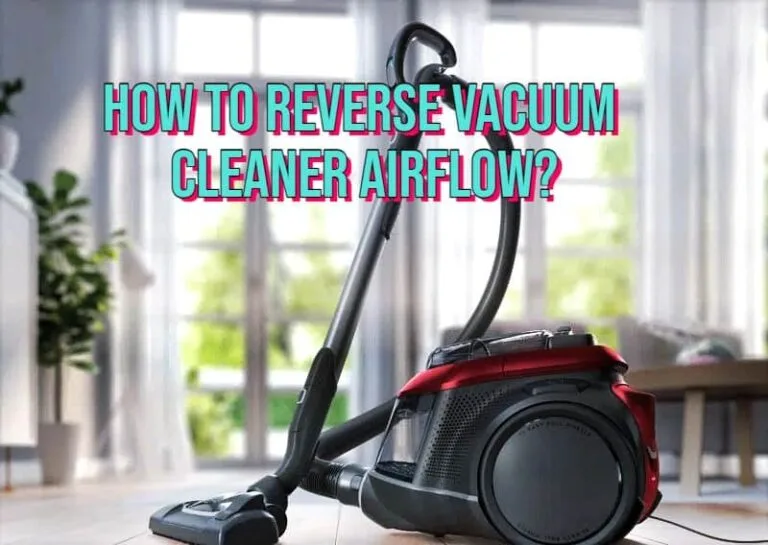Table of contents
- Reversing Airflow: Preparations and Safety Measures
- How to Reverse Airflow in Different Types of Vacuums
- Tips for Using Your Vacuum Cleaner in Blower Mode
- Not All Vacuums Are Suitable for Reversing Airflow
- Why Would You Want to Reverse Your Vacuum Cleaner’s Airflow?
- Care and Maintenance When Reversing Airflow
- Conclusion: How To Reverse Vacuum Cleaner Airflow

A vacuum cleaner is a versatile and indispensable tool in every household. While primarily used for cleaning, you might be surprised to learn that with a little knowledge and creativity, you can actually repurpose your vacuum cleaner to blow air instead of sucking it in. Yes, you read that correctly. You can reverse your vacuum cleaner’s airflow. Whether you need to inflate a mattress, clear out your computer’s dusty insides, or simply want to experiment, this detailed guide will teach you how to reverse your vacuum cleaner airflow.
Reversing Airflow: Preparations and Safety Measures
Before attempting to reverse the airflow on your vacuum, a few precautions are necessary. Make sure the vacuum cleaner is unplugged before you start tinkering with it to prevent any electrical mishaps. Also, ensure you have a clean, well-lit working space where you can easily find and manipulate the vacuum cleaner components.
Cleaning Your Vacuum Cleaner
It’s important to clean your vacuum cleaner thoroughly before using it in blow mode. The dust and debris accumulated can otherwise be blown out, creating a mess or potentially damaging the items you are cleaning or inflating.
How to Reverse Airflow in Different Types of Vacuums
Not all vacuum cleaners are designed the same way. Some vacuums have built-in features for reversing airflow, while others require a bit more effort. Let’s explore how to reverse airflow for several common types of vacuum cleaners.
Canister Vacuums
Canister vacuums are among the easiest to convert from suction to blower mode due to their design. Here are the steps:
- Detach the Hose: Unplug the hose from the suction port, where it normally attaches to the vacuum.
- Attach to the Exhaust Port: Find the exhaust port of your vacuum cleaner (usually at the rear). Plug the hose into this port.
- Check the Seal: Make sure the hose fits securely into the exhaust port. If it doesn’t fit snugly, you might need to use duct tape to secure it and prevent air leaks.
- Turn on the Vacuum Cleaner: Once your setup is secure, turn on your vacuum cleaner. It should now blow air out of the hose instead of sucking it in.
Shop Vacs or Wet/Dry Vacuums
Wet/Dry vacuums, often known as Shop Vacs (a popular brand name), typically have a built-in blower feature. Here’s how to use it:
- Locate the Blower Port: Identify the blower port on your vacuum. It’s usually clearly marked and located on the opposite side of the vacuum from the suction port.
- Remove the Hose from the Suction Port: Disconnect the hose from the suction port where it normally attaches.
- Attach the Hose to the Blower Port: Connect the hose to the blower port. Make sure the connection is secure.
- Power on the Vacuum: Turn on your vacuum cleaner. It should now function as a blower.
Upright Vacuums
Upright vacuums are typically more challenging to convert to blow mode, and not all models will allow for this conversion. If your upright vacuum has a detachable hose and a separate exhaust port, you might be able to use it as a blower. If not, it’s likely best to stick with using it in its intended suction mode to avoid damaging the machine.
Bagless Vacuums
For bagless vacuums, the steps to reverse airflow will depend on the design. If the vacuum has an easily accessible and detachable exhaust filter, you can potentially remove the filter, attach the hose to the exhaust port, and use the vacuum as a blower. However, this is not recommended for all models, especially those without a separate exhaust port, as it can cause damage to the vacuum or create a dusty mess.
Tips for Using Your Vacuum Cleaner in Blower Mode
Once you’ve converted your vacuum cleaner to a blower, there are a few tips to keep in mind:
- Always hold the hose securely when the vacuum is in blower mode. The force of the air might be stronger than you expect.
- Use a narrow attachment on the end of the hose for more focused and powerful airflow.
- When using the vacuum as a blower to clear dust (for example, from computer components), keep a safe distance to avoid damaging sensitive parts.
- Once you’ve finished using the vacuum as a blower, don’t forget to reassemble it properly for its original function.
Not All Vacuums Are Suitable for Reversing Airflow
While many vacuum cleaners can be converted into blowers, it’s important to note that not all models are designed to accommodate this. Some vacuums, particularly older models or budget options, may not have a detachable hose or a separate exhaust port. In such cases, it’s best to stick to using the vacuum in its intended suction mode to avoid causing damage. Always consult the user manual or manufacturer’s guidelines if you’re uncertain.
Why Would You Want to Reverse Your Vacuum Cleaner’s Airflow?
Now that we’ve covered how to reverse the airflow in your vacuum cleaner, you might be asking yourself why you would want to do this. Beyond the satisfaction of learning something new about a common household appliance, there are a few practical reasons:
Inflating Items
A vacuum cleaner in blower mode can be an effective tool for inflating items like air mattresses, inflatable pools, or balloons. This can be a real time-saver compared to manually inflating these items and can also be more cost-effective than purchasing a separate air pump.
Dusting and Cleaning
A reversed vacuum can be used to blow dust off items or out of areas that are hard to reach with traditional dusting tools. This can be particularly useful for cleaning electronics, such as computers or game consoles, where dust can accumulate over time and potentially cause overheating or other issues.
Drying Wet Surfaces
If you’ve just mopped your floor or cleaned your carpet and need it to dry quickly, using your vacuum cleaner in blower mode can speed up the process. The forceful air can help evaporate the moisture faster, leaving your surfaces dry and clean.
Gardening and Outdoor Use
Reversed vacuum cleaners can be handy in the garden or for outdoor tasks. You can use it to blow leaves or small debris off your driveway, patio, or garden paths, essentially turning your vacuum into a leaf blower.
Care and Maintenance When Reversing Airflow
If you plan to frequently use your vacuum cleaner as a blower, it’s important to keep up with regular care and maintenance to ensure the vacuum continues to operate effectively in both modes.
Regular Cleaning
Frequently clean out the dust bag or container to prevent debris from being blown out when the vacuum is in blower mode. Also, clean the hose and attachments to prevent dust build-up, which can reduce the efficiency of the vacuum and blower.
Check the Filters
Inspect the vacuum’s filters regularly and clean or replace them as necessary. The filters are crucial for trapping small particles when the vacuum is used for suction, and they ensure clean air is expelled when the vacuum is used as a blower.
Inspect the Hose and Attachments
Regularly inspect the hose and attachments for any signs of wear and tear. If the hose becomes cracked or damaged, it may not create a proper seal when attached to the exhaust port, reducing the effectiveness of the blower.
Conclusion: How To Reverse Vacuum Cleaner Airflow
Reversing the airflow on your vacuum cleaner can open up a range of new uses for this common household appliance, from dusting delicate electronics to inflating air mattresses. However, not all vacuums are suitable for this modification, and it’s essential to take care to avoid causing damage to the vacuum or the items you’re cleaning. By understanding the operation of your vacuum cleaner and taking the appropriate precautions, you can unlock the full potential of your vacuum and turn it into a versatile tool for more than just cleaning floors.
